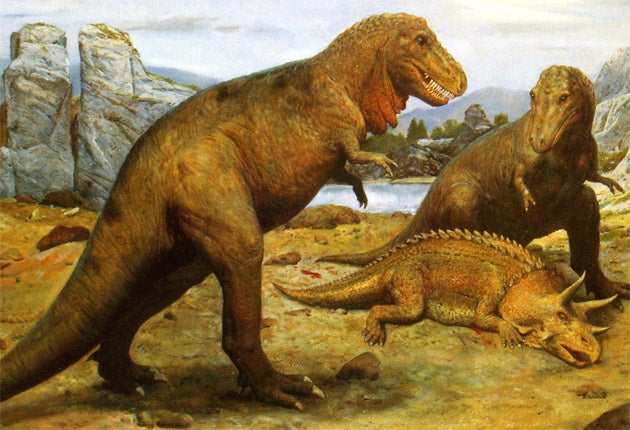Jurassic bully: Pick on someone your own size...
... and you might have thought the T.rex would. But scientists now think it preferred to prey on baby dinosaurs

Your support helps us to tell the story
From reproductive rights to climate change to Big Tech, The Independent is on the ground when the story is developing. Whether it's investigating the financials of Elon Musk's pro-Trump PAC or producing our latest documentary, 'The A Word', which shines a light on the American women fighting for reproductive rights, we know how important it is to parse out the facts from the messaging.
At such a critical moment in US history, we need reporters on the ground. Your donation allows us to keep sending journalists to speak to both sides of the story.
The Independent is trusted by Americans across the entire political spectrum. And unlike many other quality news outlets, we choose not to lock Americans out of our reporting and analysis with paywalls. We believe quality journalism should be available to everyone, paid for by those who can afford it.
Your support makes all the difference.It was the biggest-ever carnivore to stalk the land and with banana-sized teeth and a set of jawbones that could swallow a kitchen table, Tyrannosaurus rex truly earned its name as king of the dinosaurs. But now scientists may have uncovered T.rex's dirty secret – it was a prolific baby killer.
A study into the predatory habits and diet of the biggest and most ferocious of the dinosaurs has concluded that T.rex and the other members of its carnivorous theropod family preferred to dine on juvenile prey, preferably small enough to eat whole.
The Hollywood image of T.rex – epitomised in Steven Spielberg's 1993 hit movie Jurassic Park – is of an aggressively agile giant that stalked and killed herbivorous animals of a similar or even larger size, such as the three-horned Triceratops or the long-necked Diplodocus.
These bloody encounters between lumbering giants may have made for dramatic imagery but the reality was probably far different, according to two palaeontologists who believe that T.rex and the other massive meat-eating dinosaurs that hunted on two legs preferred to pick on animals far smaller than themselves.
Titantic struggles between consenting adults may well have happened on some occasions but a far more likely scenario is that the Tyrannosaurs preferred to tuck into small and unwary juveniles rather than their fully-grown and dangerously armoured parents, explains David Hone, a British-born palaeontologist working in China.
"Modern predators mainly attack vulnerable, young animals as they are inexperienced in evading predators, and this was probably the same in dinosaurs," said Dr Hone, who works at the Institute of Vertebrate Palaeontology and Palaeoanthropology in Beijing.
"Young prey are easier to bring down and the risk of injury to the predator is much lower," he said.
Working with Oliver Rauhut of the Bavarian State Collection for Palaeontology and Geology in Munich, Dr Hone has reviewed the evidence suggesting that T.rex and its family went in for baby-eating in a big way. The two scientists also suggest that baby-eating was such a common behaviour among the large predatory dinosaurs that it could explain why the remains of so few juvenile dinosaurs have been found in the fossil record.
"We conclude that, like modern predators, theropods preferentially hunted and ate juvenile animals leading to the absence of small, and especially young, dinosaurs in the fossil record," the scientists conclude in their study published in the journal Lethaia.
"The traditional view of large theropods hunting the adults of large or giant dinosaur species is therefore considered unlikely and such events rare," they add.
It is known from preserved dinosaur nests that they produced many offspring and it is highly likely that most of them did not reach adulthood, with many of them falling prey to predators in their first few years of life
"Finds of dinosaur nesting sites indicate that dinosaurs laid large number of eggs and thus had very high numbers of offspring but little of this is reflected in the numbers of young in the fossil record," said Dr Rauhut.
But the two scientists also believe that eating baby dinosaurs whole or in large pieces by digesting them with the help of their stomach acids gave T.rex the added advantage of being able to utilise the minerals and nutrients stored in the bones of their small prey.
This could also explain why scientists have found so few bite marks on fossilised dinosaur bones, if it was indeed the case that T.rex and its ilk preferred to eat the bodies of juveniles whole or in large pieces –just like modern crocodiles and birds of prey such as eagles.
What little evidence there is from the fossil record supports this, said Dr Hone. "Although there are few records, where we do have the bones of prey species preserved in the stomachs of carnivorous dinosaurs they are from juveniles," he said.
Studies of dinosaur stomach contents and coprolites – fossil faeces – also suggest that prey was indeed swallowed whole, Dr Hone said. "Juvenile animals may have been systematically the primary prey of choice for the majority of theropods," he said.
Subscribe to Independent Premium to bookmark this article
Want to bookmark your favourite articles and stories to read or reference later? Start your Independent Premium subscription today.
Join our commenting forum
Join thought-provoking conversations, follow other Independent readers and see their replies
Comments